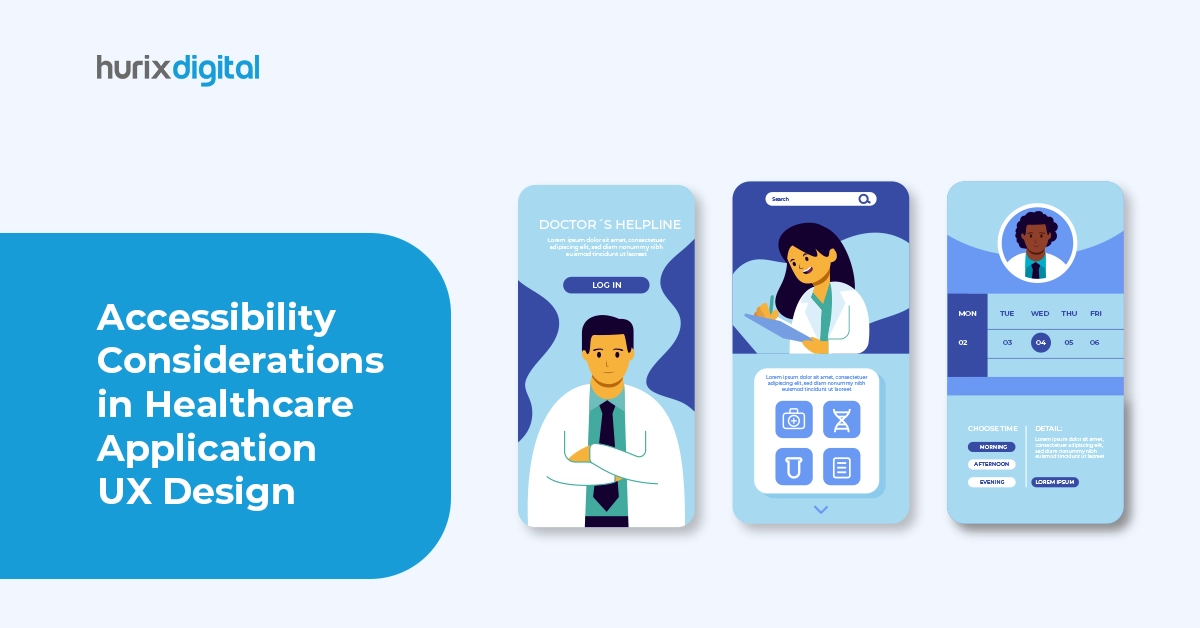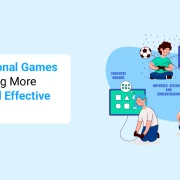
Accessibility Considerations in Healthcare Application UX Design
Summary
Discover key considerations for designing accessible healthcare applications. This article offers insights into creating user experiences that meet accessibility standards.
Healthcare UX design is a keystone in the field of digital advancement, influencing how patients use technology to manage their health and well-being.
Hence, it is imperative to take note of the significance of accessible user interface (UI) and user experience (UX) design in the intricate field of healthcare, where every choice can have a profound effect. As healthcare systems are undergoing a shift to the digital realm, thoughtful design becomes crucial to ensure that healthcare applications are accessible to all users, including those with disabilities.
This blog explores the significance of healthcare application accessibility UX design, along with tips for making inclusive and simple-to-use user interfaces for all.
Table of Contents:
- Common Accessibility Challenges in Healthcare Apps
- How to Design an Accessible Healthcare Application UX Design?
- Best Practices to Ensure Healthcare Application Accessibility
- Takeaway
Common Accessibility Challenges in Healthcare Apps
To ensure inclusivity in healthcare technology, it’s critical to consider common accessibility concerns. The majority of these are connected to the user’s physical capabilities and limitations.
- Patients with visual impairments may find navigating difficult when using healthcare applications without sufficient text-to-speech support or alternative text descriptions for buttons and images.
- Complex menu structures, ambiguous labeling, and incoherent navigation patterns may make navigation difficult for users with cognitive disabilities or learning impairments.
- Individuals with motor impairments may experience disappointment and decreased usability when trying to select small touch targets on mobile devices.
- Color-blind users with low vision may find it difficult to distinguish between different elements on the screen and read text due to poor color contrast in user interface elements.
- When addressing an array of consumers, multiple modes may be necessary for forms that have specified input methods.
- Certain features might need to be responsive when a service or good is being accessed on smaller, handheld devices.
Also Read: The Beginner’s Guide to Accessibility Remediation – What You Need to Know!
How to Design an Accessible Healthcare Application UX Design?
It is crucial to develop an accessible healthcare user experience (UX) to guarantee that all individuals, irrespective of ability, can utilize, comprehend, and gain advantages from digital healthcare services.
The most effective way to get started is by complying with accessibility standards for healthcare apps. Here are some effective strategies for the best possible outcomes!
1. Embracing the Principles of Universal Design
The tenets of inclusive design center on making surroundings, solutions, and goods simpler to use regardless of users’ conditions or skills. In terms of the healthcare user experience, this means developing digital health systems that are easy to use, understandable, and accessible to the largest number of users.
Mobile health app accessibility can be greatly improved by including several navigation methods, such as touch, spoken instructions, mouse interactions, and typing inputs. This guarantees that users of various skill levels can efficiently interact with the application.
2. Abiding by the Web Content Accessibility Guidelines (WCAG)
Organizations can benefit from WCAG for offering digital accessibility in healthcare technology. Detailed instructions for designing accessible and intuitive digital user interfaces can be found in these guidelines.
They also offer helpful instructions, such as ensuring text descriptions are included for nontextual content and allowing full keyboard features. By adhering to these guidelines, you can produce adaptive content that looks great across a range of formats without losing any data.
For example, text-to-speech technology makes it easier for users to read screen text and makes app navigation simpler. To enable text-to-speech software to explain the website’s visuals, icons, and other visual components, healthcare apps, and websites must adhere to the WCAG principle of offering text alternatives for nontextual content.
3. Providing User Evaluations and Responding to Input
Evaluating the accessibility of a healthcare application is an ongoing process that is integrated into its phases of development and updates rather than a one-time endeavor.
By implementing the routine evaluation of healthcare services, the team can make sure that accessibility standards are upheld or even exceeded as an application develops.
You can enhance the user experience and demonstrate your dedication to accessibility guidelines for healthcare applications by routinely soliciting input from users and promptly addressing issues. For instance, you must test an application on a range of users, including people with disabilities, to garner a variety of accessibility-related comments.
Best Practices to Ensure Healthcare Application Accessibility
Developers should adhere to best practices for designing accessible UX when developing healthcare applications to solve these accessibility issues and produce inclusive and user-friendly applications for all patients. Among the crucial factors are:
- Keyboard Accessibility: Ensure that all of the application’s interactive components are keyboard accessible so that users can use keyboard controls to navigate the interface instead of a mouse or touch screen.
- Use of Alt Text: To guarantee that users with visual impairments can comprehend the content and features of images, buttons, and icons, present alternative text explanations for each of these elements.
- Color Contrast: Avoid depending just on color to convey data; instead, use high-contrast color schemes. Ensure the important elements stand out visually and the text is readable against the background.
- Consistent Navigation: To make the application easier to use and comprehend for users with cognitive disabilities or learning impairments, keep the navigation patterns unified and the labeling apparent.
- Text Resize and Zoom: To meet varying visual requirements and choices, let users resize text and enlarge content. This will guarantee that text is always readable and accessible.
- Multimodal interactions: These guarantee that users can react to interactive components in an application by using more than one sense modality. This involves integrating responses that are tangible, visual, or auditory to support a greater variety of user requirements and skills.
- Form Design: To help users complete tasks properly, optimize form fields, and include clear instructions. You can use relevant form validation messages and error handling to guide users through the process.
- Language diversity: Since digital healthcare is an international field, UX designers must consider language diversity. Thus, to improve a platform’s accessibility for users who need to be fluent in the default language, think about assisting in multiple languages.
- Simple User Interface: The intricacy of healthcare systems frequently overwhelms users. UX designers can resist this propensity by creating user interfaces for applications that are straightforward to understand and use standard symbols, organized designs, and intuitive navigation.
Also Read: Slicing the Importance of Digital Accessibility in the Healthcare Industry
Takeaway
Ensuring that people with disabilities can efficiently access and utilize essential healthcare services requires the accessibility of healthcare applications. Individuals with disabilities encompassing visual, auditory, motor, or cognitive domains frequently encounter obstacles when utilizing digital healthcare resources, thereby considerably affecting their capacity to manage their health effectively.
The UX design of healthcare applications can be made more inclusive and equitable for all patients, regardless of their abilities, by including accessibility considerations.
If you are looking for designing or accessibility testing in healthcare apps, get in touch with Hurix Digital. Through the implementation of best practices and accessibility audits, we guarantee that your website or applications are accessible to people with disabilities, thereby offering an equitable user experience to all.
Contact us to know more!

Vice President – Digital Content Transformation. He is PMP, CSM, and CPACC certified and has 20+ years of experience in Project Management, Delivery Management, and managing the Offshore Development Centre (ODC).



